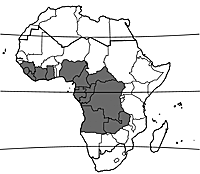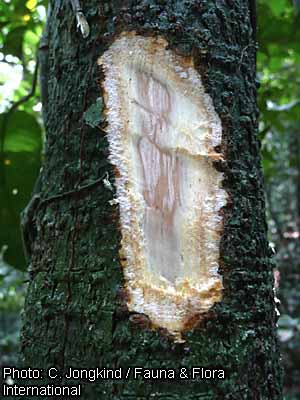Aulacocalyx jasminiflora (PROTA)
Introduction |
Aulacocalyx jasminiflora Hook.f.
- Protologue: Icon. pl. 12(2): t. 1126 (1873).
- Family: Rubiaceae
Origin and geographic distribution
Aulacocalyx jasminiflora is distributed from Sierra Leone, Liberia and eastern Guinea through West and Central Africa to Zambia and Angola.
Uses
The stems, which are often curved, are used as boat-ribs and fence posts. Twigs are used as chew-sticks. In Liberia small saplings are often used for making spring-traps.
Properties
The wood is hard. The stems are strong, flexible and resilient.
Description
- Evergreen shrub or small tree up to 12(–15) m tall; bole slender, up to 20 cm in diameter, fluted, without buttresses; inner bark orange-cream, with yellow streaks, with bitter scent and taste; twigs silky orange-brown hairy, becoming glabrous.
- Leaves opposite, simple and entire; stipules fused, triangular, 3–10 mm long, bristly hairy, caducous; petiole 2–8(–9) mm long, hairy; blade elliptical to oblong to oblanceolate, (6.5–)8–16(–19) cm × 1.5–6(–9) cm, base cuneate to rounded, apex acuminate, thinly leathery, thinly hairy on veins below, pinnately veined with 2–6 pairs of lateral veins and many conspicuous parallel small veins.
- Inflorescence a terminal fascicle on short branchlets subtended by 1 leaf, up to 20-flowered, hairy; peduncle 0.5–3(–5) mm long.
- Flowers bisexual, regular, 5(–6)-merous, sweetly fragrant, nearly sessile; calyx with 2–7 mm long tube, usually distinctly grooved, lobes triangular to deltate, 1–5 mm long; corolla white or greenish white, densely covered with silvery white or yellowish hairs, with 1–2.5(–3) cm long tube, lobes elliptical to oblong, (0.5–)1–1.5(–2) cm long, spreading or reflexed; stamens without filaments, anthers attached below their midpoint to the top of the corolla tube, 7–20 mm long; ovary inferior, 2-celled, style thread-shaped or narrowly club-shaped, about as long as corolla, stigma 2-lobed.
- Fruit a nearly globose berry 8–12 mm in diameter, yellow-hairy, green, with persistent calyx at apex, 2–4-seeded.
- Seeds nearly globose, 8–9 mm × 5–8 mm, black when dry.
Other botanical information
In West Africa Aulacocalyx jasminiflora flowers in November–February and bears fruits in February–April.
Aulacocalyx comprises 8 species, distributed in tropical Africa. It seems most closely related to Heinsenia.
Ecology
Aulacocalyx jasminiflora occurs from sea-level up to 1500 m altitude in the understorey of primary forest, secondary forest and gallery forest.
Genetic resources
As Aulacocalyx jasminiflora has a wide distribution and is locally common, it is not threatened with genetic erosion.
Prospects
Little is known of the uses of the wood of Aulacocalyx jasminiflora, and quantitative information on the wood properties is lacking altogether. In view of the small size of the tree and its limited actual use, the importance of the wood of Aulacocalyx jasminiflora is unlikely to increase.
Major references
- Bridson, D. & Verdcourt, B., 2003. Rubiaceae (Cinchonoideae). In: Pope, G.V. (Editor). Flora Zambesiaca. Volume 5, part 3. Royal Botanic Gardens, Kew, Richmond, United Kingdom. 720 pp.
- Burkill, H.M., 1997. The useful plants of West Tropical Africa. 2nd Edition. Volume 4, Families M–R. Royal Botanic Gardens, Kew, Richmond, United Kingdom. 969 pp.
- Figueiredo, E., 1997. A Revision of Aulacocalyx (Rubiaceae - Gardenieae). Kew Bulletin 52(3): 637–658.
- Hallé, N., 1970. Rubiacées (2e partie). Flore du Gabon. Volume 17. Muséum National d’Histoire Naturelle, Paris, France. 335 pp.
Other references
- Hawthorne, W., 1990. Field guide to the forest trees of Ghana. Natural Resources Institute, for the Overseas Development Administration, London, United Kingdom. 275 pp.
- Hawthorne, W.D., 1995. Ecological profiles of Ghanaian forest trees. Tropical Forestry Papers 29. Oxford Forestry Institute, Department of Plant Sciences, University of Oxford, United Kingdom. 345 pp.
- Hawthorne, W. & Jongkind, C., 2006. Woody plants of western African forests: a guide to the forest trees, shrubs and lianes from Senegal to Ghana. Kew Publishing, Royal Botanic Gardens, Kew, United Kingdom. 1023 pp.
- Hepper, F.N. & Keay, R.W.J., 1963. Rubiaceae. In: Hepper, F.N. (Editor). Flora of West Tropical Africa. Volume 2. 2nd Edition. Crown Agents for Oversea Governments and Administrations, London, United Kingdom. pp. 104–223.
- Irvine, F.R., 1961. Woody plants of Ghana, with special reference to their uses. Oxford University Press, London, United Kingdom. 868 pp.
Author(s)
- M. Brink, PROTA Network Office Europe, Wageningen University, P.O. Box 341, 6700 AH Wageningen, Netherlands
Correct citation of this article
Brink, M., 2012. Aulacocalyx jasminiflora Hook.f. In: Lemmens, R.H.M.J., Louppe, D. & Oteng-Amoako, A.A. (Editors). PROTA (Plant Resources of Tropical Africa / Ressources végétales de l’Afrique tropicale), Wageningen, Netherlands. Accessed 31 May 2025.
- See the Prota4U database.





